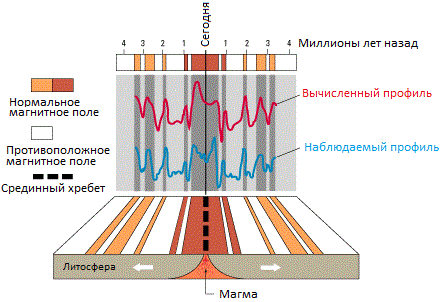Categories: Featured Articles » Interesting Facts
Number of views: 6284
Comments on the article: 2
Earth's magnetic field
Earth's magnetic field is similar to the magnetic field of a giant permanent magnet, tilted at an angle of 11 degrees to the axis of its rotation. But there is a nuance, the essence of which is that the Curie temperature for iron is only 770 ° C, while the temperature of the Earth’s iron core is much higher, and only on its surface is about 6000 ° C. At such a temperature, our magnet would not be able to maintain its magnetization. So, since the core of our planet is not magnetic, terrestrial magnetism has a different nature. So, where does the Earth’s magnetic field come from?

As you know, magnetic fields are surrounded by electric currents, so there is every reason to assume that the currents circulating in the molten metal core are the source of the earth's magnetic field. The shape of the Earth’s magnetic field is indeed similar to the magnetic field of a current loop.
The magnitude of the magnetic field measured on the surface of the Earth is about half of Gauss, while the lines of force seem to come out of the planet from the south pole and enter its north pole. At the same time, magnetic induction varies from 0.3 to 0.6 Gauss over the entire surface of the planet.
Practically, the Earth’s presence of a magnetic field is explained by the dynamo effect arising from the current circulating in its core, but this magnetic field is not always constant in direction. Rock samples taken in the same places but of different ages differ in the direction of magnetization. Geologists report that over the past 71 million years the Earth’s magnetic field has unfolded 171 times!

Although the dynamo effect has not been studied in detail, the rotation of the Earth definitely plays an important role in the generation of currents, which are supposed to be the source of the Earth's magnetic field.
The Mariner 2 probe, which examined Venus, found that Venus does not have such a magnetic field, although its core, like the core of the Earth, contains enough iron.
The answer is that the rotation period of Venus around its axis is 243 days on Earth, that is, the dynamo generator of Venus rotates 243 times slower, and this is not enough to produce a real dynamo effect.
Interacting with particles of the solar wind, the Earth's magnetic field creates conditions for the appearance of the so-called auroras near the poles.
The north side of the compass needle is the magnetic north pole, which is always oriented towards the geographic north pole, which is practically the magnetic south pole. After all, as you know, opposite magnetic poles are mutually attracted.
However, a simple question: “how does the earth get its magnetic field?” - still does not have a definite answer. It is clear that the generation of a magnetic field is associated with the rotation of the planet around its axis, because Venus with a similar composition of the nucleus, but rotating 243 times slower, does not have a measurable magnetic field.
It seems plausible that the rotation of the liquid of the metal core, which makes up the bulk of this core, gives rise to a picture of a rotating conductor that creates a dynamo effect and works like an electric generator.
Convection in the liquid of the outer part of the core leads to its circulation in relation to the Earth. This means that the electrically conductive material moves relative to the magnetic field. If it is charged due to friction between the layers in the core, then the effect of a turn with current is quite possible. Such a current is quite capable of supporting the Earth's magnetic field. Large-scale computer models confirm the reality of this theory.

In the 1950s, as part of the Cold War strategy, US Navy vessels towed sensitive magnetometers across the ocean floor, while they were looking for a way to detect Soviet submarines.In the course of observations, it turned out that the Earth's magnetic field fluctuates within 10% with respect to the magnetism of the seabed rocks directly, which had the opposite direction of magnetization. The result was a picture of U-turns that took place up to 4 million years ago; this was calculated by the potassium-argon archaeological method.
See also at bgv.electricianexp.com
:
